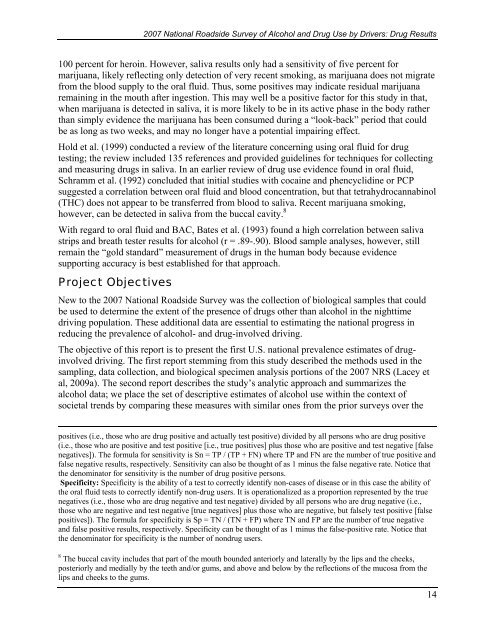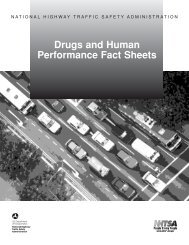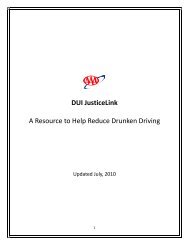2007 National Roadside Survey of Alcohol and Drug Use by Drivers
2007 National Roadside Survey of Alcohol and Drug Use by Drivers
2007 National Roadside Survey of Alcohol and Drug Use by Drivers
Create successful ePaper yourself
Turn your PDF publications into a flip-book with our unique Google optimized e-Paper software.
<strong>2007</strong> <strong>National</strong> <strong>Roadside</strong> <strong>Survey</strong> <strong>of</strong> <strong>Alcohol</strong> <strong>and</strong> <strong>Drug</strong> <strong>Use</strong> <strong>by</strong> <strong>Drivers</strong>: <strong>Drug</strong> Results100 percent for heroin. However, saliva results only had a sensitivity <strong>of</strong> five percent formarijuana, likely reflecting only detection <strong>of</strong> very recent smoking, as marijuana does not migratefrom the blood supply to the oral fluid. Thus, some positives may indicate residual marijuanaremaining in the mouth after ingestion. This may well be a positive factor for this study in that,when marijuana is detected in saliva, it is more likely to be in its active phase in the body ratherthan simply evidence the marijuana has been consumed during a “look-back” period that couldbe as long as two weeks, <strong>and</strong> may no longer have a potential impairing effect.Hold et al. (1999) conducted a review <strong>of</strong> the literature concerning using oral fluid for drugtesting; the review included 135 references <strong>and</strong> provided guidelines for techniques for collecting<strong>and</strong> measuring drugs in saliva. In an earlier review <strong>of</strong> drug use evidence found in oral fluid,Schramm et al. (1992) concluded that initial studies with cocaine <strong>and</strong> phencyclidine or PCPsuggested a correlation between oral fluid <strong>and</strong> blood concentration, but that tetrahydrocannabinol(THC) does not appear to be transferred from blood to saliva. Recent marijuana smoking,however, can be detected in saliva from the buccal cavity. 8With regard to oral fluid <strong>and</strong> BAC, Bates et al. (1993) found a high correlation between salivastrips <strong>and</strong> breath tester results for alcohol (r = .89-.90). Blood sample analyses, however, stillremain the “gold st<strong>and</strong>ard” measurement <strong>of</strong> drugs in the human body because evidencesupporting accuracy is best established for that approach.Project ObjectivesNew to the <strong>2007</strong> <strong>National</strong> <strong>Roadside</strong> <strong>Survey</strong> was the collection <strong>of</strong> biological samples that couldbe used to determine the extent <strong>of</strong> the presence <strong>of</strong> drugs other than alcohol in the nighttimedriving population. These additional data are essential to estimating the national progress inreducing the prevalence <strong>of</strong> alcohol- <strong>and</strong> drug-involved driving.The objective <strong>of</strong> this report is to present the first U.S. national prevalence estimates <strong>of</strong> druginvolveddriving. The first report stemming from this study described the methods used in thesampling, data collection, <strong>and</strong> biological specimen analysis portions <strong>of</strong> the <strong>2007</strong> NRS (Lacey etal, 2009a). The second report describes the study’s analytic approach <strong>and</strong> summarizes thealcohol data; we place the set <strong>of</strong> descriptive estimates <strong>of</strong> alcohol use within the context <strong>of</strong>societal trends <strong>by</strong> comparing these measures with similar ones from the prior surveys over thepositives (i.e., those who are drug positive <strong>and</strong> actually test positive) divided <strong>by</strong> all persons who are drug positive(i.e., those who are positive <strong>and</strong> test positive [i.e., true positives] plus those who are positive <strong>and</strong> test negative [falsenegatives]). The formula for sensitivity is Sn = TP / (TP + FN) where TP <strong>and</strong> FN are the number <strong>of</strong> true positive <strong>and</strong>false negative results, respectively. Sensitivity can also be thought <strong>of</strong> as 1 minus the false negative rate. Notice thatthe denominator for sensitivity is the number <strong>of</strong> drug positive persons.Specificity: Specificity is the ability <strong>of</strong> a test to correctly identify non-cases <strong>of</strong> disease or in this case the ability <strong>of</strong>the oral fluid tests to correctly identify non-drug users. It is operationalized as a proportion represented <strong>by</strong> the truenegatives (i.e., those who are drug negative <strong>and</strong> test negative) divided <strong>by</strong> all persons who are drug negative (i.e.,those who are negative <strong>and</strong> test negative [true negatives] plus those who are negative, but falsely test positive [falsepositives]). The formula for specificity is Sp = TN / (TN + FP) where TN <strong>and</strong> FP are the number <strong>of</strong> true negative<strong>and</strong> false positive results, respectively. Specificity can be thought <strong>of</strong> as 1 minus the false-positive rate. Notice thatthe denominator for specificity is the number <strong>of</strong> nondrug users.8 The buccal cavity includes that part <strong>of</strong> the mouth bounded anteriorly <strong>and</strong> laterally <strong>by</strong> the lips <strong>and</strong> the cheeks,posteriorly <strong>and</strong> medially <strong>by</strong> the teeth <strong>and</strong>/or gums, <strong>and</strong> above <strong>and</strong> below <strong>by</strong> the reflections <strong>of</strong> the mucosa from thelips <strong>and</strong> cheeks to the gums.14




